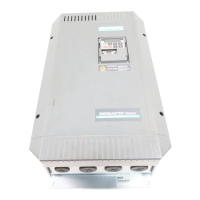Parameterizing Steps 05.2006
6SE7087-2JD60 Siemens AG
9-62 Operating Instructions SIMOVERT MASTERDRIVES
P107 = 52.00 Hz Rated motor frequency
P108 = 1500.0 rpm Rated motor speed
P109 = 2 Motor pole pair number
Pre-assignment:
P352 = 52.00 Hz Reference frequency
P353 = 1560 rpm Reference speed
For a maximum speed of four times the rated motor speed you must set
the reference speed to at least 3000 rpm. The reference frequency is
adjusted automatically (P352 = P353 / 60 x P109).
P352 = 100.00 Hz
P353 = 3000 rpm
A setpoint speed of 1500 rpm corresponds to a setpoint frequency of
50.00 Hz or an automation value of 50.0 %.
The representation range ends at 6000 rpm (2 x 3000 rpm).
This does not affect the internal representation range of the control
system. Since the internal control signals refer to the rated motor
quantities, there is always sufficient reserve control capacity.
The reference speed should normally be set to the desired maximum
speed.
Reference frequencies of P352 = P107, P352 = 2 x P107,
P352 = 4 x P107 are favorable for the calculating time.
For a maximum torque of three times the rated motor torque (P113) it is
advisable to set the reference torque to between twice and four times
the value of parameter P113 (for four to eight times the representation
range).
Function diagrams and start-up instructions for separately excited
synchronous motors (with damping cage and excitation via sliprings)
are available as separate instructions.
The following parameters are only effective for these synchronous
motors:
P75 to P88; P155 to r168, P187, P258, P274, P297, P298, P301, r302,
P306 to P312.
Example
Separately excited
synchronous
motors
